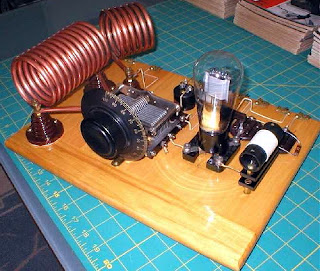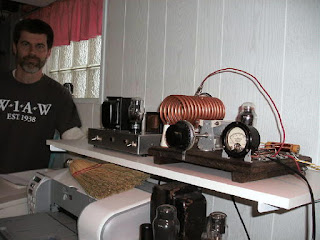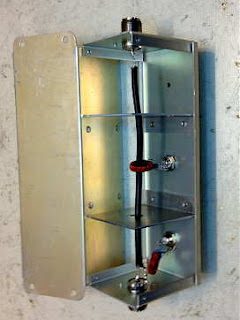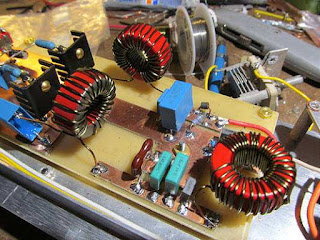Posts Tagged ‘homebrew’
 ’29 BK QSO Party – Night #2
’29 BK QSO Party – Night #2
Weekend #2 for the 1929 Bruce Kelley QSO Party found propagation even poorer than the first weekend.
With the 'K' index rising to level 4 along with the arrival of high speed solar winds, it was an uphill battle once again. And as usual, the terrestrial winds were relentless at 60-90km/h here for the entire event ... the worst winds I have experienced during any previous BK's.
The new MOPA did not suffer from the same level of frequency jumping as my previously used Hartley or TNT oscillators but the high winds were still able to cause some melodic pulling of the oscillator. Apparently there is still enough trickle-down coupling from the PA to the oscillator when high winds cause sudden shifts in impedance or resonance of the antenna ... but generally I was much happier with the new BK transmitter.
This year's BK QSO total was the lowest I have had, with just 29 QSO's. A few more were added on Saturday night as well as early Sunday morning, including one QSO on topband.
KK7UV, Steve in Montana, can always be counted on for a clean-sweep and working him on 160m completed that task again this year. Steve's extensive fall antenna work has really payed off as his '29 signal was always impressive up this way. His 160m Hartley signal was a solid 579.
 |
| KK7UV - Hull Hartley |
Hats off to Bill, K4JYS in North Carolina, as once again his signal seemed to be the one most consistently heard here, on both 40m and 80m. Bill runs a single-wire off-center fed Hertz at 40', as described in December 1929 QST and it seems to work very well.
 |
| K4JYS - 210 Hartley |
George, N3GJ in Pennsylvania was worked along with Larry, W2LB in New York. Larry's 5W Hartley signal was an amazing 559 and solid copy. His breadboard '29 rig is proof that it doesn't have to be pretty to do the job and join the fun!
| W2LB - 227 5W Hartley |
Another one of the night's highlights was working Lou, VE3AWA, on 80m, who I had missed the previous weekend. So far, Lou and I have never failed to work each other on 80m but it was looking rather dire until his signal suddenly popped-up shortly before 8PM, keeping our record intact.
 |
| VE3AWA - 210 TNT |
These stations were worked on weekend #2 ... Hartley oscillators having the edge once again.
40m
W7LNG TNT 10w OR
W8KGI MOPA 10w NM
N2BE Hartley 10w NJ
W2LB Hartley 5w NY
80m
VE3AWA TNT 10w ON
N3GJ Hartley 9w PA
W2LB Hartley 5w NY
KØKP Hartley 10w MN
KØKCY MOPA 10w MN
160m
KK7UV Hartley 10w MT
Please do consider putting something together for next year's BK Party as more new activity, particularly from the western side of the continent, is always wonderful to see and adds much more excitement to the party.
You might find the three-part 'Building '29 Style' links on the right sidebar of some interest should you be planning on joining the fun and ... if you are looking for help, you will find many '29 ops willing to do what they can to get you BK-ready on Yahoo's AWAGroup. Everyone would love to work you next year!
 ’29 BK QSO Party – Night #1
’29 BK QSO Party – Night #1
 |
| Harold - KB0ROB |
This past Friday night's wonderful propagation during the ARRL 160m CW Contest, pretty much went into the dumper for Saturday night's 1929 Bruce Kelley QSO Party, sponsored by the Antique Wireless Association.
In spite of the auroral-like conditions, with the K-index reaching level '5', the melodic tones from many of the old (and new) clunkers could be heard pounding out their annual 'CQ AWA' invitations.
Among my 19 contacts (8 on 40m and 11 80m), the highlight of the night was working W2ICE/1 in Maine on both 40 and 80m. In reality, this was Paul, N1BUG, operating Bruce Kelley's original 10 watt TNT, which rose to almost S9 levels on 40m, once the sun had set. The Kelley transmitter is moved to various locations each year, a new AWA tradition.
As well, Larry (NE1S), also in Maine, was worked on 40m with his 10W TNT.
A new station for my '29 logbook was George (N3GJ), in Pennsylvania. George was managing 8 watts input to his version of a 1929 TNT.
When I first tuned-in, several years ago, to hear what these 1929 signals sounded like, two of the best sounding signals were coming from KBØROB (Harold), shown at the top, and KBØMM (Burt), both in Minnesota. I could hardly believe they were using era-appropriate rigs as their signals sounded as good as many modern rigs. Thankfully nothing has changed, as these two stations continue to hand out 'MN' using their well-built 'MOPA'-style time machines.
Scott, WA9WFA, the BK score-keeper in charge of logs, faded up briefly with his fine-looking Colpitts.
Here is a list of the '29ers worked so far, along with their rig style and DC power inputs.
40m
KK7UV Hartley 10w MT
W2ICE/1 TNT 10w ME
NE1S TNT 10w ME
VE7BDQ Colpitts 8w BC
K7SF Hartley 10w OR
K4JYS Hartley 10w NC
WB2AWQ Hartley 10w NV
N3GJ TNT 8w PA
80m
KBØMM MOPA 8w MN
KBØROB MOPA 9w MN
W7LNG TNT 7w OR
K4JYS Hartley 10w NC
W2ICE/1 TNT 10w ME
WA9WFA Colpitts 20w MN
KK7UV Hartley 10w MT
W9TFC Hartley 10w WI
N2BE Hartley 10w NJ
KIØDB MOPA 10w MN
WØLGU MOPA 10w MN
As you can see, 'Hartley' construction takes a slight edge. Vintage 'handbooks' and magazine articles from the era, have always promoted the TNT as the best 'beginners' rig but in reality, the Hartley is much easier to build and to get working with a good-sounding signal. The TNT requires some finicky tweaking of the grid coil in order to have an equally stable-sounding note.
I'm happy to report that in spite of the very high winds (as usual), my new MOPA's tone remained virtually unmoving ... for the most part! This was its first real workout and after my first QSO on 80m, my frequency began making large jumps and suddenly sounding very unstable, along with fluctuations in power output. My initial thought was that one of the old original mica caps was starting to breakdown.
After disconnecting one lead of each capacitor (one at a time) and temporarily clipping in a modern substitute, I was no further ahead. I had originally isolated the frequency instability to the amplifier stage and there was only one thing left ... the amplifier's grid-leak resistor. It appeared to be slowly failing, by increasing resistance in jumps. The 12K resistor was now measuring ten times that value and quickly rising. A new 12K, temporarily clipped in place, cured the problem but it had cost me over an hour of operating time ... probably the best prop of the night as by the time I got back on the band, signals were weak and auroral-sounding.
Hopefully the bands will have mended themselves by next Saturday night, allowing some of the smaller eastern stations to make it back to the west coast for some memorable '29 'transcons'.
 More Low Noise Vertical (LNV) Construction
More Low Noise Vertical (LNV) Construction
 |
| New LNV At WG2XKA |
The low-noise vertical discussed here previously, has recently been implemented by at least three of the 630m experimental stations. John, WG2XKA / WA3ETD, along with Ken, WG2XXM / K5DNL and John, WG2XIQ / KB5NJD, have all constructed versions of this receiving antenna after reading about the details here.
John's antenna, pictured above, is described in more detail here, along with some nice pictures of his matching transformer.
All stations report good results with the antenna so it may be something you might want to consider if your present receiving antenna is a noise-collector.
For those interested in getting started on 630m, John (WG2XIQ), has a ton of inspiring information available on his website here as does John (WG2XKA) on his site here.
 The 1929 ‘BK’ QSO Party
The 1929 ‘BK’ QSO Party
 The month of December will soon be upon us and that means it's 'BK' time once again! The Bruce Kelley 1929 QSO Party is the annual two-weekend event celebrating the sound of amateur radio as it was in 1929.
The month of December will soon be upon us and that means it's 'BK' time once again! The Bruce Kelley 1929 QSO Party is the annual two-weekend event celebrating the sound of amateur radio as it was in 1929.At no other time of the year can you tune across the bands and hear the melodic sound of radio as it once was ... before the days of crystal-control, when most hams were using self-excited one or two-tube transmitters.
With antennas blowing in the wind, these directly-coupled oscillators often make the band sound like a musical symphony gone wrong ... the wonderful whooping, chirping, buzzing, clicking, drifting, swishing, swaying, warbling, and other interesting sounds of '29, when amateur radio was in its infancy.
If you've ever considered joining-in on the fun, then you still have a few weeks to slap something together for the party ... it need not be 'pretty', but it must be 'compliant'. That is, the tube (or tubes) that you use, must have been available in 1929 or earlier. For receiving, use anything you like ... modern or vintage, as there are no restrictions.
I've penned several blogs on popular circuits and tubes that are commonly used among the BK regulars and they can be viewed here:
Building '29 Style
Building '29 - What To Build? - PT.1
Building '29 - What To Build? - PT.2
More BK Building
With the usual propagation of early December, it is not surprising that many transcontinental QSO's are made every year, even with the little two or three watters. Considering the 10 watt power input rule, it is surprising how strong some signals from across the country can become on the lower bands, especially on 40m.
Please consider rolling-up your sleeves, heating up your soldering iron and putting something together for the BK fun, especially if you are on the left coast ... and don't be the least concerned about how it looks!
For a gallery of inspiration from individuals that were too weak to resist the temptation, have a look at some previously built '29 time machines.
For the first time, I'll be using my newly constructed MOPA, a two-tuber that will hopefully reduce my annual BK windstorm angst. It seems that every BK weekend, I have gale-force winds here on the island, making my signal a little bit 'too musical', although some '29 diehards still claim to love the sound ... for them, there is no hope.
 New VE7 On 630m
New VE7 On 630m
Another VE7 is almost ready to deploy on 630m.
There must be something special in the water in B.C. as it is certainly the present hotbed of 630m activity in Canada!
Markus, VE7CA, in North Vancouver, has been busy building a transmitter and a matching VFO, following the plans of GW3UEP. There must now be dozens and dozens of these robust little transmitters in operation around the world as it is easily reproducible (in various forms) and performs well. See the sidebar links for more details.
As well, Markus has been building the necessary auxiliary gear needed to tune up and resonate his antenna system. His recently constructed variometer and scopematch are shown below.
Some might argue of the necessity for a scopematch, but once you've tried it, you wonder how you could ever live without it ... the scopematch makes tuning the antenna system a very simple step and is an extremely valuable addition to the LF/MF shack.
Markus plans on using his main low band antenna, a large ladder-line fed horizontal loop, as a top-loaded vertical, while resonating the system with base-loading. A homebrew relay-control box at the antenna, takes care of switching between MF and HF.
I had a nice CW QSO today on 476.0 kHz with Toby, VE7CNF. He has made some significant changes at his station and his 20dB over S9 signal reflects his hard work. As well as rebuilding his top-loaded vertical, he has made modifications to his PA. Using a pair of IRFP4227 switching FETs in push-pull, his amplifier now brings him to the maximum EIRP limit of 5W. See a description of Toby's interesting station on his website here. When not on CW, Toby can be heard WSPR'ing, most evenings on 630m.
With the soon-to-arrive VE7CA, we almost have enough activity here in the Vancouver region, for a weekly 630m net or at least a good chance of a random 'CQ' garnering a response. How great it would be to have a VE6 or VE5 to join-in ... what say fellas!
 West Coast 630m Growth
West Coast 630m Growth

The Canadian west coast contingent of stations on 630m continues to slowly expand, with Mark, VA7MM and Toby, VE7CNF now operational at 'DX capable' power levels.
Both Mark and Toby have been refining their antenna systems with an eye towards the upcoming winter season as well as the November 'crossband' activity weekend ... both stations were heard testing this week and are sounding very strong at my Mayne Island location.
Toby has sent a picture of his antenna loading coil and variometer scheme, shown below.
"You can see the white slider knob at the lower left, which goes through a slot in the outer pipe and screws into the end of the inner pipe. The white wire at the right goes to the matching transformer, and the black high-voltage wire at the left goes to the antenna. The coil is wound with #14 so it can handle some power. There are ventilation holes around the pipe and at the ends, but at 200W I did not notice any warming. A regular rotating variometer may have slightly lower losses, but it would be larger and I wanted to make my tuner box small so I can hide it near the trees."
 Mark also sent some pictures of his recent handiwork, showing the simple loading coil and tuning system presently in use at his station. His present plans call for something capable of handling power in the 100 watt range and, although using smaller gauge wire, the loading coil seems to handle it just fine. Like Toby, he is using a 'sliding variometer' and a toroidal autotransformer for impedance matching to 50 ohms. Mark will be running ~ 100 watts into a 100' vertical wire with top-loading.
Mark also sent some pictures of his recent handiwork, showing the simple loading coil and tuning system presently in use at his station. His present plans call for something capable of handling power in the 100 watt range and, although using smaller gauge wire, the loading coil seems to handle it just fine. Like Toby, he is using a 'sliding variometer' and a toroidal autotransformer for impedance matching to 50 ohms. Mark will be running ~ 100 watts into a 100' vertical wire with top-loading.It is wonderful to see more new stations arriving on the band but the new activity seems to be coming from VE7 only ... how interesting it would be to have stations in VE6, the prairies and especially from Ontario, which has many more hams than any of the other provinces. The opportunities presented to Canadian amateurs by the new band are both boundless and challenging and there is so much that can be learned by 'jumping in'!
Another western amateur has caught the 630m bug, this one from the U.S.A. Steve, KK7UV, in Montana, has been busy building new antennas as well as a new GW3UEP transmitter. Operating with an experimental licence, WH2XNV, Steve has been putting a nice CW signal up this way during the evenings and is all set for the winter and, hopefully, for the fast-approaching day when the boys on the other side of the border get full access to 630m as a ham band. All of us up here very much look forward to working our U.S. counterparts very soon.
Steve's new antenna consists of an 81' vertical wire, top-loaded with a 3-wire 68' x 8' tophat. His ground system now has over 4,000' of radials, ranging in size from 40'-130'.
Steve also reports modifying his dual-FET (parallelled) GW3UEP transmitter from the original solenoid-wound coils to toroidal cores, increasing efficiency from 74% to 77%.
As well, he also went to a single-FET (per the original design) and garnered a further increase in efficiency, now at 86% and 82 watts out ... plenty of power to do some useful work on the band. It's wonderful to see how 630 meters brings out the 'experimenter' in all of us. He also reports that he's "having a bunch of fun at this ... "!
If homebrewing is your main interest, all of the 630m stations that I'm familiar with are using home-built transmitters. Maybe you like tinkering with antennas? This band is perfect for the design and development of small, yet effective, backyard antennas ... most will be surprised at how little is needed to radiate a usable signal on 630m. Perhaps propagation is your main interest? There is still much to be learned about the capabilities of our stations, operating at amateur radio power levels, in the MF band.
As mentioned before, we are really very fortunate here in Canada, to have this amazingly interesting part of the radio spectrum made available to us ... let's try and use it, from coast to coast and everywhere in between.
VE6, VE5, VE4, VE3, VE2 and VE1 ... the band needs you!
 Autumn = projects time
Autumn = projects time
I usually cycle to work. Wow I hear you say, what a guy….Well thanks but I hadn’t finished the introduction. Cycling means you notice the seasons a lot more than if you drive. Its still the season for shorts and after some very mild days we’re definitely heading towards fully developed autumn. So what?
Well its time to spend fewer hours outside (because you’ll be blown across the street) and more time preparing for those murky days when projects are preferable to souwesters.
This year I have got a couple of PCB’s that need populating. 1 of them is the Budd Churchward Morseduino. The other is the Minima Transceiver.
Budd created a neat little barebones arduino and morse code decoder and he kindly gave me the gerbers. It is essentially a very simple device that will allow audio to pass through and it will give a reasonable decode of CW. I say reasonable because it is never going to be as good as your purists ears but it’ll help get the less talented on the air (hopefully). This video gives you a flavour
Project 2 it the Minima Transceiver, by Ashran Farhan of BitX fame. It is my first foray into complete rig build for the experimenter so I’m expecting some tinker time. Essentially it is a Arduino controlled simple transceiver (Any spot the link here?). This will be a lot more involved and I’m just getting my head around the schematic.
There seems to be a lot of useful information about so if I get stuck then google will no doubt be my friend! Here’s a little taster.




























